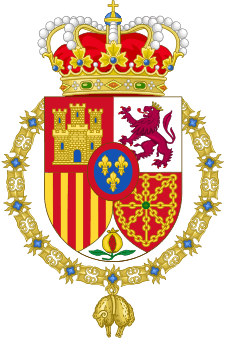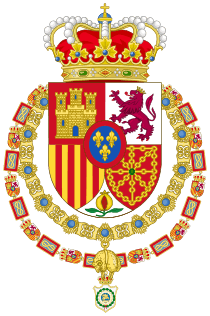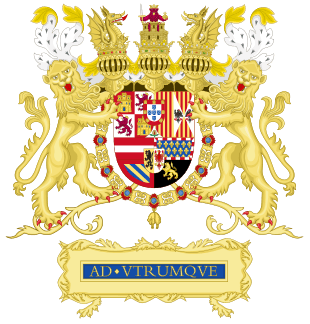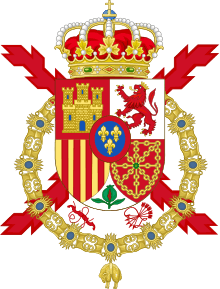Coat of arms of the King of Spain
| Coat of arms of the King of Spain | |
|---|---|
 | |
| Details | |
| Armiger | Felipe VI |
| Adopted | 19 June 2014 |
| Crest | Spanish Royal Crown |
| Escutcheon | Quarterly: Castile, León, Aragon, and Navarre; enté en point: Granada; inescutcheon Bourbon (Anjou Branch) |
| Orders | Order of the Golden Fleece |
| Earlier versions | See below |
The blazoning of the coat of arms of the King of Spain is regulated by the Royal Decree 527/2014, 20 June, an amendment to Title II of Spanish Royal Decree 1511/1977 adopting Flags, Standards, Guidons, Insignia and Emblems Regulation.[1] The coat of arms was adopted when King Felipe VI was enthroned as King of Spain.[2]
Official blazon
The shield is divided into four quarters, blazoned as follows:
- 1st, gules a castle or, triple-embattled and voided gate and windows, with three towers each triple-turreted, of the field, masoned sable and ajoure azure, which is for Castile;
- 2nd, argent a lion rampant purpure crowned or, langued and armed, of the second, which is for León;
- 3rd, or, four pallets gules, which is for Aragon;
- 4th, gules a cross, saltire and orle of chains linked together or, a centre point vert, which is for Navarre;
Argent enté en point, with a pomegranate proper seeded gules, supported, sculpted and leafed in two leaves vert, which is for Granada.
Inescutcheon azure bordure gules, three fleurs-de-lys or, which is for Bourbon-Anjou.
All surrounded by the collar of the Golden Fleece and crowned with a crown of the same metal and precious stones, with eight rosettes, five visible, and eight pearls interspersed, closed at the top by eight diadems also adorned with pearls and surmounted by a cross on a globe, which is the royal crown of Spain.[3]
In 1969, General Francisco Franco appointed Juan Carlos I as his "successor to the Headship of the Spanish state with the title of King" but gave him the new title of Prince of Spain instead of the traditional title of Prince of Asturias. From 1971 to 1975, Juan Carlos as Prince of Spain used a coat of arms which was virtually identical to the one later adopted when he became King in 1975. Earlier coat of arms differed only that it featured the royal crown of a Crown Prince of Spain, the King's royal crown has eight half-arches of which five are visible, while the Prince's one has only four half-arches of which three are visible.[4] Joined to the shield was the red saltire of Burgundy and, to the dexter and sinister of the base point, the yoke gules in its natural position with ribbons, of the field, and the sheaf of five arrows gules with the arrowheads inverted and ribbons, of the field, which used to be the symbol of the Catholic Monarchs of Spain.
Since June 2014, Juan Carlos's son, Felipe VI, has been using the same arms but without the cross of Burgundy, yoke and arrows.[5] King Juan Carlos's arms include a red lion instead of the purple one displayed on the current version[6]
Variants
| Variants of the coat of arms of the King of Spain | |||
|---|---|---|---|
 |
 |
 |
 |
| Variant as Grand Master of the Order of Charles III Surrounded by the collar of this order |
Variant as Grand Master of the Order of Isabella the Catholic Surrounded by the collar of this order |
Variant as Grand Master of the Order of Saint Ferdinand Surrounded by the grand master's collar |
Variant as Grand Master of the Order of Saint Hermenegild Surrounded by the grand master's collar of this order |
Ornamented versions of the historical royal coats of arms
- For common versions and the changes of the heraldic charges and the divisions of the field, see Coat of arms of Spain.
| Royal Arms | Monarch | Supporters | Other ornaments | Motto |
|---|---|---|---|---|
| House of Trastamara (1475–1506) | ||||
.svg.png) |
The Catholic Monarchs |
|
|
|
.svg.png) |
The Catholic Monarchs |
|
|
Tanto monta |
.svg.png) |
Ferdinand II of Aragon |
|
||
 |
Joanna of Castile |
|
|
|
 |
Philip I of Castile |
|
|
Qui voudra |
| House of Habsburg (1506–1700) | ||||
.svg.png) |
Charles I |
|
|
Plus oultre |
.svg.png) |
Charles I |
|
|
Plus ultra |
.svg.png) |
Charles I |
|
|
Plus ultra |
.svg.png) |
Philip II |
|
|
Nec spe, nec metu |
.svg.png) |
Philip II |
|
|
Nec spe, nec metu |
.svg.png) |
Philip II |
|
|
Non sufficit orbis |
 |
Philip III |
|
|
Ad utrumque |
.svg.png) |
Philip IV |
|
|
Ad utrumque |
| House of Bourbon (1700–1808 / 1813-1868 / 1874-1931) | ||||
.svg.png) |
Philip V |
|
|
|
.svg.png) |
Charles III |
|
|
|
| French occupation (1808–1813) | ||||
 |
Joseph Bonaparte |
|
|
|
| House of Savoy (1870–1873) | ||||
 |
Amadeus |
|
|
Nec plus ultra |
| House of Bourbon (1931) | ||||
.svg.png) |
Alfonso XIII |
|
|
Plus ultra |
 |
Juan Carlos I |
|
||
See also
References
- ↑ "Real Decreto 527/2014, de 20 de junio, por el que se crea el Guión y el Estandarte de Su Majestad el Rey Felipe VI y se modifica el Reglamento de Banderas y Estandartes, Guiones, Insignias y Distintivos, aprobado por Real Decreto 1511/1977, de 21 de enero." [Royal Decree 527/2014 setting up the Guidon and Standard of HM King Felipe VI and amends Standards, Guidons, Insignia and Emblems Regulation, adopted on Royal Decree 1511/1977] (PDF). BOE Spanish Official Journal (in Spanish). 20 June 2014. Retrieved 2014-06-21.
- ↑ "Felipe VI ya cuenta con escudo y guión propios" [Felipe VI has his own coat of arms and guidon]. www.heraldo.es (in Spanish). 2014-06-19. Retrieved 2014-06-20.
- ↑ Coat of arms of His Majesty the King of Spain. The Royal Household of the King of Spain. Retrieved 19 October 2011.
- ↑ (Spanish) Spanish Decree 814 of 22nd April 1971. Boletín Oficial del Estado, Official Gazette of the Spanish Government, no. 99. Retrieved 19 October 2011.
- ↑ "Coat of arms of His Majesty King Juan Carlos". Spanish Royal Household Website. 2014-06-19. Retrieved 2014-06-20.
- ↑ "Coat of arms of His Majesty the King". Spanish Royal Household Website. 2014-06-19. Retrieved 2014-06-20.
External links
- Description of the Standard and Coat of arms of the King at Flags of the World
- Origins and History of the Spanish coat of arms (Spanish)